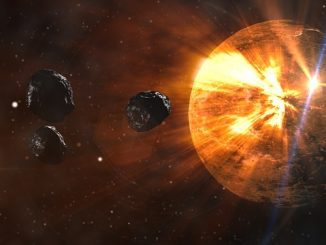
Albert Einstein was an extraordinary physicist who came up with theories that can only be described as nothing short of brilliant. Nobody would have ever thought though that one day history books would challenge his theories under the premise that perhaps he thought them wrong. And for a man that less than a century ago was the most radical physics thinker around, that’s simply mind-boggling.
But, we’re now living in a world where discovering something not previously believed possible is becoming more common. And scientific thoughts that have been accepted for centuries are now being questioned.
Einstein might have been right most of the time, but not all of the time. And whether you want to believe it or not, here are five of his most notable mistakes.
The Cosmological Constant
In order to make his General Theory of Relativity applicable to the structure of the universe and to counteract the force of gravity, Einstein came up with what he called “the cosmological constant” — a constant number or one that has an unchanging value. He incorporated this number to balance both sides of the equation, thereby giving us a picture of a static universe.
We now know that the opposite is true. There is indeed a counteractive force, a dark energy. But rather than keeping our universe constant, it’s one that’s causing our universe to expand at an accelerating speed.
Gravitational Lensing
Gravity can bend light. And part of Einstein’s equations described how. In 1936, he published an article that detailed how stars acted like lenses, deviating and diverting light as affected by gravitational pull. While he was able to describe it — the more massive the star, the greater the degree of bending — he also explicitly mentioned that such event can never be directly observed because it was too infinitesimal to be seen.
Now we can probably attribute this dismissal to the idea that Einstein only applied the concept of gravitational lensing to individual stars, and not entire galaxies. And it was a critical error, especially because this has come to be one of the most widely applied techniques used by scientists and astronomers to map the universe.
Quantum Mechanics
Einstein referred to it as “spooky action at a distance” — a phenomenon that suggests objects influence each other, even at great distances. While he was aware of the possibility, he rejected the idea because he thought it was not realistic to think that objects can physically affect one another, especially when they were so far apart. Besides, he did not think the phenomenon could ever be verified.
And he turned out to be wrong. Several experiments and studies conducted by different groups of scientists are getting closer than ever to proving for certain that quantum mechanics is real.
The Speed of Light
The speed at which light travels is variable, not constant. It still remains to be proven, but it directly contradicts Einstein’s theory that the speed of light has always been constant. If the model being built to test it works as intended, it will show that as the universe was just forming, light travelled way faster than it does today, and only slowed down to its constant speed we know right now as a result of the changing density of the universe.
Gravitational Waves and Black Holes
Einstein proposed that colliding black holes create ripples in the fabric of space-time (i.e. gravitational waves), and anything that falls into a black hole disappears completely, with no chance of ever escaping, and leaving no trace. He knew that black holes had to exist, but his theories about the nature of black holes were contradictory.
With the discovery of three gravitational wave events last year, a part of his theory was confirmed, but a part of it has also become debatable, specifically that which says the black hole’s event horizon (i.e. its boundary) is completely invisible. Because if this was accurate, gravitational waves should not have been detected in the first place.
Albert Einstein helped change the world. There’s no question about that. And though he did commit some errors too, for all of his invaluable contributions to the world of science, we’re pretty sure nobody faults him for that. He may be a genius, but he’s still human after all.
- Bulenox: Get 45% to 91% OFF ... Use Discount Code: UNO
- Risk Our Money Not Yours | Get 50% to 90% OFF ... Use Discount Code: MMBVBKSM
Disclaimer: This page contains affiliate links. If you choose to make a purchase after clicking a link, we may receive a commission at no additional cost to you. Thank you for your support!




On that speed of light thing.
I like fringe science, it is kind of neat and serves some purpose; mainly making scientific dogma defend itself. But, fringe science should not get a free ride.
OK, if light speed where slowing down then we would see a blue shift from the more distant objects in the universe; we don’t.
Also, for this to be happening would imply that the speed of light would increase in heavier gravity; it doesn’t.
(I am not posting the math for eather,it is just high school math)
Concerning the black hole thing, Einstein just did calculations on the non-spinning Schwarsheld (sp) singularities a type that probably do not exist. So I am inclined to let that one slide.
I think it is fair to say that Einstein was a quantum theory denialist. You left out the most interesting thing about quantum theory. He CORRECTLY made a profound application of quantum theory to demonstrate that the theory implied “spooky action at a distance.” He didn’t believe that any such prediction could possibly be correct but the actual work he did was in fact correct. Some four decades later the predictions were confirmed. This should be contrasted with today’s climate denailists who contribute nothing to science and nothing to humanity.
Your description of Einstein’s rejection of quantum mechanics is bizarre and wrong. He won his Nobel Prize not for Relativity, but for his 1905 article on the wave/quanta nature of light. This proved to be a major force in moving quantum mechanics forward. Even Max Planck took years to understand it. Einstein made other significant contributions to the field before he grew wary of quantum mechanics’ radically counterintuitive nature. He tried to disprove it and failed. It was during this phase that he understood “spooky action at a distance.” He prefaced it by saying he didn’t like it but that it must be true — in the past decade this has proven to be the case. It is the sign of a great scientific mind to reveal something to reveal something others have not understood when it goes against what you are trying to prove.
You are also wrong about the cosmological constant. At first he thought he had made a mistake by including this term, which represents a repulsive force. Because he was told by astronomers that the universe was in steady state, so a repulsive force was needed to counteract gravity.
Now we know that the universe is not in steady state, but expanding and accelerating. So he was right the first time, about a nonzero cosmological constant.
Pifflesnortz! I don’t ‘know’ anything so please try to skip the ‘we’ appeal to bandwagon fallacy. But I thimk that Aarp pointed out some succinct hints of the what’s there to know — and a ‘fatal flaw’ in current understanding that ‘establishes’ the ‘expanding and accelerating’ universe. Let’s all work to re-establish the difference between ‘discredited’ and ‘disproven’ that is the keystone of current newspeak.